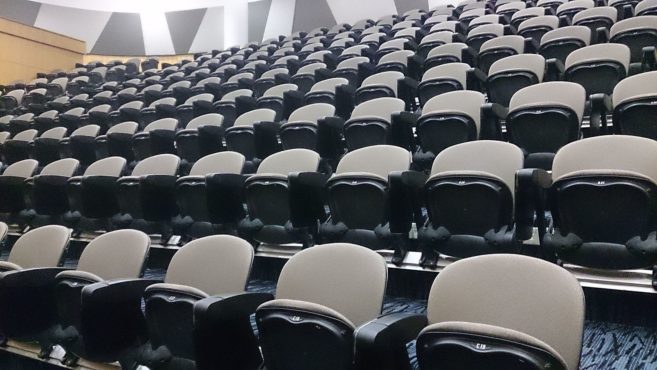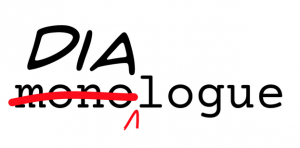#SciFund Challenge Class
Part 12: Preparing for the Presentation
In this guide, we have discussed the importance of identifying career goals that you would like to achieve at your poster session. We also have focused heavily on the narrative of our poster. Now it’s time to combine these lessons to plan our poster presentation (you know: the part where you have a conversation with your audience at your poster). As you will see, it is not enough to have a great looking poster. To have the most impact, your presentation and poster will need to be in perfect harmony. Remember, one of the main goals of presenting a poster is to make a connection. So let’s connect!
What to wear
Particularly for those who are new to academic conferences, deciding what to wear can be challenging. There isn’t any need to obsess though, because the name of the game is simple: blend in. Whatever is the standard mode of dress at your conference is what you should aim for. Of course, the “standard mode” of dressing varies greatly across conferences. Ecologists are famous for wearing shorts and sandals at their meetings; medical and health types are much more likely to have ties and skirts.
How do you find out how people dress at the conference you are attending? Ask your colleagues who have attended that conference – or a similar conference – in the recent past.
Across conferences though, there is one hard and fast rule: wear comfortable footwear. After all, you will likely be standing by your poster for several hours.

How do you get people to show up at your poster?
One of the central points of this class is that the main purpose of the poster is to start conversations between you and the people you want to connect with. So, how do you get those people over to your poster?
A critical mistake is assuming that the people in your target audience are naturally going to wander by your poster. Conferences are busy places. Without external prodding, it is almost certain that most of your target audience won’t even be aware that your poster exists and will miss your poster session.

As a consequence, it is essential to inform the people in your target audience about your poster before your poster session. There are tons of great ways to get the word out.
- If there is a conference hashtag, tweet that you are giving your poster. In fact, tweet a lot about other stuff you see and do at the conference. People following conference tweets may like what you are doing, and stop by just to say hi.
- If people in your lab or other colleagues are giving talks at the conference, ask them to mention, during their talks, that your poster session is coming up. And vice versa, your colleagues will surely appreciate it if you mention their upcoming talks during your poster session.
- Ask your advisor or supervisor to bring up your poster session with his or her colleagues at the scientific meeting.
- Go to the talks and poster sessions of people in your target audience and directly mention your poster to them at an appropriate point.
- Make it easy for people that you meet at the conference to remember that your poster session is happening. To do this, make business cards that give the time and location of your poster session. You don’t have to get fancy business cards professionally produced at great expense. Instead, design a very simple card and print it out on your own printer, using business card paper. You can buy this at most standard stationery stores.
- Most importantly: talk to people! It can be intimidating to talk to researchers you don’t personally know, particularly those who are eminent in your field. But remember, everyone comes to conferences for the express purpose of talking to people. Why shouldn’t they talk to you? It is the experience of all the instructors of this class (who have cumulatively spent 30 zillion man-hours in conferences) that people at scientific meetings are generally quite approachable.
Two factors play a big role in determining how much work you’ll need to put into getting people to show up at your poster session. First, the bigger the conference, the more work you’ll need to do. At conferences that draw several thousand people, there is a bewildering array of activities planned for every moment. Consequently, the chances that your target audience will not know about your poster session are exceptionally high. Further, the number of posters at a given poster session is usually much greater at big conferences, requiring effort to cut through the clutter in even your own poster session.
However, even at small conferences, it makes sense to get the word out. After all, even if there are not alternative sessions at the time of your poster session, people always have the option of skipping it to catch up on e-mail or to get some coffee.
Here’s the second factor: is the subject of your overall poster session of general interest to the audience that you want to connect with? If your session’s subject is unlikely to naturally draw your target audience, you’ll need to put in some extra effort to get those folks to show up at your particular poster.
Bring supplies!
When you are in hour three of your poster session, you want to be focused on the people at your poster – not on how hungry you are. Bring some snacks and some water for yourself so that you can stay sharp.
Presenting Your Poster
There is much more to a poster presentation than standing next to your board and answering questions. The hallways in a poster session can be very busy and dynamic. Some people will be looking for specific posters and others will be browsing for whatever poster catches their fancy. Poster sessions demand you pay attention to a lot of things happening around you all at once.
Stand next to your poster when possible rather than sitting. Standing makes you more visible and serves as a cue that you are ready, willing, and able to talk about your poster.
Watch for people who are on the margins of your poster – particularly if you are already in conversation. It is very easy to so deep into conversation that you miss or ignore someone who wants to talk to you about your poster. Be willing to put the brakes on your current conversation to say, “Hi, I’ll be right with you” to someone who is looking at your poster. Try to acknowledge everyone, and create a space where that person can engage with you.
If someone comes up to your poster and starts reading, do not launch into them with the full story of your research, or even your elevator pitch. Ask them, “Would you like a tour of the poster?” Some people might just want to read. Others will look relieved, and say, “Yes please, tell me about your work.” Different people want different levels of engagement.

While a stock elevator pitch of your poster is a good icebreaker, remember that a poster is there to start conversations. Let the other person talk. Ask the other person if their research interests are similar. Watch for clues that the person you’re talking to might want to ask a question – say, you get a puzzled look when you explain figure 2, or eyes glaze over when you hit the third differential equation.
Tablets are a great way of showing material that doesn’t work well on paper, like videos. Laptops are just a little bit too clunky for a crowded poster session. And showing a video on a tablet is a great way to attract passers-by, who will stop just long enough to see what the video is.
It’s valuable to be able to leave physical traces of your presentation. There are at least three things that you can take with you:
- Business cards. Classic, simple, portable.
- Small handout sized versions of the poster. If your poster passes the arm’s length test, you don’t have to do any more work than printing out the poster on your desktop printer.
- Reprints of related work. You may not have this if you’re just starting, but quite often a project will be a continuation of earlier work in the lab. This can be better than emailing someone a PDF, because people might be looking for something to read in the airport or the plane on their way home.
Likewise, it can’t hurt for you to collect business cards so you can Google stalk people after the conference, and figure out who you want to follow on Twitter after the conference.


